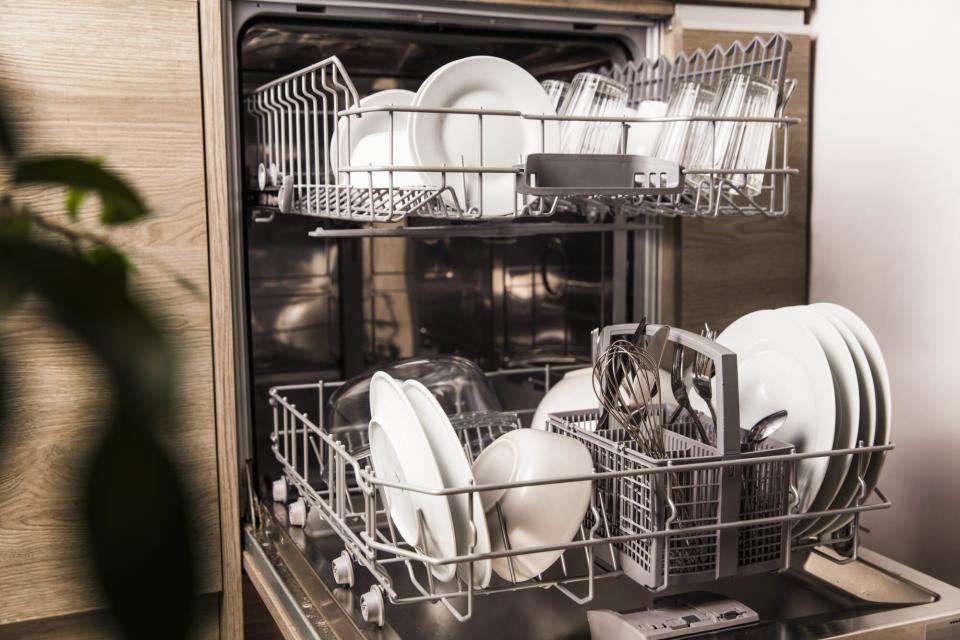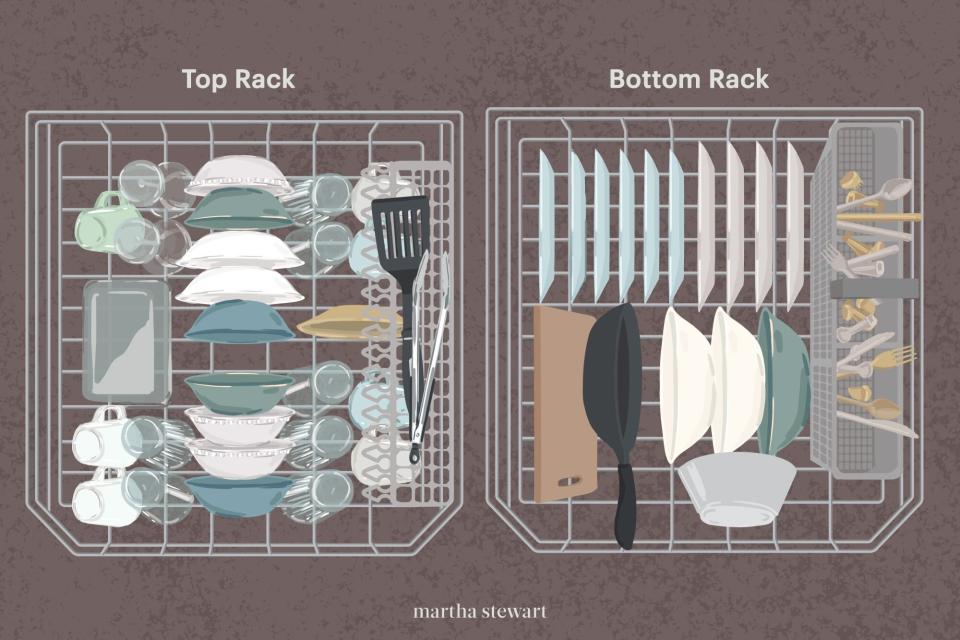How to Load Your Dishwasher the Right Way
A dishwasher is a convenient appliance that can clean a week's worth of dishes with the simple press of a button. But few things are more frustrating than when you go to unload your dishes and find that they are still covered in food residue. If this has happened to you, the main issue is likely the way you're loading your dishwasher. When cups, plates, utensils, and other serveware are placed in the machine incorrectly, it prevents the jets from completing their job. Knowing how to load your dishwasher saves you time (and water) spent re-cleaning your dishes—and makes unloading a breeze.
Related: How to Clean Your Dishwasher

Olena Ivanova / GETTY IMAGES
Dishwasher Loading Tips
Before placing dirty dishes into your machine, make sure you follow a few basic rules that will ensure a proper clean every time.
Don't Pre-Rinse Your Dishes
We understand the desire to rinse stuck-on food off your plate before putting it in the dishwasher, but it isn't necessary. "Despite what many may think, rinsing dishes beforehand may actually hinder the cleaning power of your dishwasher," says Bree Lemmen, kitchen brand manager at Whirlpool. In fact, many dishwasher models are designed with sensors meant to detect how dirty the dishes are and how to best clean them. It is recommended, though, to scrap any large items of food into the trash prior to placing them in the dishwasher.
Don't Overcrowd Your Dishwasher
Overcrowding your dishwasher will often leave you with still-dirty dishes after the cycle completes. "If your items aren't getting as clean as they usually do, you may have overcrowded the dishwasher load," says Lemmen. "Additionally, overcrowding could cause leaks or damage to your dishwasher." When loading the appliance, make sure your items aren't touching one another so the water can penetrate all sides.
Don't Block the Sprayer Arms
The sprayer arms are the hero of your dishwasher—they hold the jets that clean your dishes. "Sprayer arms are typically located in the middle of the dishwasher toward the bottom of the dishwasher," says Lemmen. "Blocking the sprayer arm does have an impact on the level of clean that your dishwasher is able to provide, so it's best to ensure nothing is in the way."
Related: Liquid, Tablet, or Powder: Which Dishwasher Detergent Cleans Best?

Grace Canaan
How to Load the Bottom Rack of Your Dishwasher
The bottom rack is where bigger items, like dinner plates, large bowls, and dishwasher-safe pots and pans, will go.
Utensils
Eating utensils should go in the basket provided with your model, which is typically located on the bottom rack of your dishwasher. "The organizer in me cannot help but separate the eating utensils in each basket of the dishwasher, and I make sure to place knives in the very last basket at the back of the dishwasher for safety," say Malaika Lubega, a professional organizer, interior decorator, and the owner of Huza Home Concepts.
Down or Up?
For the best clean, place forks and spoons with the handles down. Butter knives' handles can face up to protect your hands. Sharp knives, however, should never be run through the dishwasher; doing so could damage the handles and cause warping.
Bowls
Large bowls, like ones used for mixing or serving a big salad, should go on the bottom rack of the dishwasher. Place each bowl between the tines with the dirty side facing inward. "Be careful not to stack bowls in the dishwasher in order to ensure each bowl gets properly washed," says Lemmen.
Plates
As is the case for bowls, large plates should also go on the bottom rack of the dishwasher. Place them between the tines with the dirty side facing inward where the washer jets are located. "If your dinner plates are not vertical or stable due to narrower tine spacing, you can adjust the tine angle to improve plate loading and stability," says Lemmen.
Pots and Pans
Washing pots and pans can be a pain point for many. Save time by loading dishwasher-safe cookware on the bottom rack towards the sides or back corners of your machine. Pots should face downward over the tines, while flat pans or baking sheets should face dirty-side in at a downward angle. "Nonstick and cast iron pans should not be washed in the dishwasher," says Lemmen.
Cutting Boards
Cutting boards fit best along the sides and back of your dishwasher's bottom rack. Be sure to read the care instructions prior to washing a cutting board to ensure it's dishwasher-safe. Cutting boards made with wooden materials should never go in the dishwasher.
How to Load the Top Rack of Your Dishwasher
The top rack of your dishwasher is where lighter items, like small bowls and small plates, go, as well as any dishwasher-safe plastic items.
Long Utensils
Many dishwashers come with a specialty rack for long utensils, like spatulas and ladles, which are too long to keep in the basket with the rest of your cutlery. If you don't have a pre-designated area, these items should lay flat on the top rack of your machine.
Drinkware
All drinkware—mugs, cups, wine glasses, and more—should be placed on the top rack of the dishwasher, facing upside down for the most thorough clean. "To keep items secure, we recommend lining cups and mugs along the side and in between the tines, versus on top," says Lemmen. "For the best drying results, mugs can be placed at a slight angle to prevent water puddles from collecting or pooling during the wash."
Plates
Load small plates, like the ones you'd use to serve dessert or appetizers, on the top rack of your dishwasher. "It's recommended they are placed vertically and toward the center of the rack," Lemmen says.
Bowls
Similar to plates, small bowls should be loaded on the top rack. Place them vertically between the tines and on an inclination toward the spray arm. Space each bowl out properly so it isn't laying on another bowl or plate.
Plastic Containers
Always load plastic items, like food storage containers, on the top rack to prevent them from getting overheated, which could cause them to warp or melt. These items should face downward in between the tines, like your cups and mugs. "Always be sure to confirm that plastic items are designated as dishwasher-safe before loading, which can typically be found on the bottom of the item," says Lemmen.

